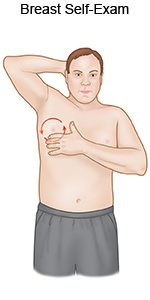Male Breast Self Exam
Medically reviewed by Drugs.com. Last updated on Aug 4, 2025.
A male breast self-exam (MBSE) is a way to check your breasts for lumps and other changes. Breast cancer and other breast problems are more common in women but can occur in men. Your risk is increased if you have a family member with breast cancer or are taking certain medicines. Regular BSEs can help you know how your breasts normally look and feel. Most breast lumps or changes are not cancer, but you should always have them checked by a healthcare provider.
DISCHARGE INSTRUCTIONS:
Call your doctor if:
- You find any lumps or changes in your breasts.
- You have breast pain, or fluid is coming from your nipples.
- You have questions or concerns or concerns about your condition or care.
Why you should do an MBSE:
Even if you have mammograms, you may still want to do a BSE regularly. If you know how your breasts normally feel and look, it may help you know when to contact your healthcare provider. Mammograms can miss some cancers. You may find a lump during a BSE that did not show up on your mammogram.
When you should do an MBSE:
If your risk for breast cancer is high, you may want to do MBSEs regularly, such as each month. This can help you find changes or problems as soon as possible. One easy way to remember is to do the exam on the same day of each month. Talk to your healthcare provider about how often to do MBSEs. He or she may give you a recommendation based on your age and other breast cancer risk factors.
How to do an MBSE:
- Look at your breasts in a mirror. Look at the size and shape of each breast and nipple. Check for swelling, lumps, dimpling, scaly skin, or other skin changes. Look for nipple changes, such as a nipple that is painful or beginning to pull inward. Gently squeeze both nipples and check to see if fluid comes out of them. If you find any of these or other breast changes, contact your healthcare provider. Check your breasts while you sit or stand in the following 3 positions:
- Hang your arms down at your sides.
- Raise your hands and join them behind your head.
- Put firm pressure with your hands on your hips. Bend slightly forward while you look at your breasts in the mirror.

- Lie down and feel your breasts. When you lie down, your breast tissue spreads out evenly over your chest. This makes it easier for you to feel for lumps and anything that may not be normal for your breasts. Examine one breast at a time.
- Place a small pillow or towel under your left shoulder. Put your left arm behind your head.
- Use the 3 middle fingers of your right hand. Use your fingertip pads, on the top of your fingers. Your fingertip pad is the most sensitive part of your finger.
- Use small circles to feel your breast tissue. Use your fingertip pads to make dime-sized, overlapping circles on your breast and armpits. First, press lightly. Second, press with medium pressure to feel a little deeper into the breast. Last, use firm pressure to feel deep within your breast.
- Examine your entire breast area. Examine the breast area from above the breast to below the breast where you feel only ribs. Make small circles with your fingertips, starting in the middle of your armpit. Make circles going up and down the breast area. Continue toward your breast and all the way across it. Examine the area from your armpit all the way over to the middle of your chest (breastbone). Stop at the middle of your chest.
- Move the pillow or towel to your right shoulder, and put your right arm behind your head. Use the 3 fingertip pads of your left hand. Repeat the above steps to do a BSE on your right breast.
Follow up with your doctor as directed:
He or she may recommend a mammogram or other tests if you find a lump during an MBSE. He or she can tell you how often to have these tests. Write down your questions so you remember to ask them during your visits.
© Copyright Merative 2025 Information is for End User's use only and may not be sold, redistributed or otherwise used for commercial purposes.
The above information is an educational aid only. It is not intended as medical advice for individual conditions or treatments. Talk to your doctor, nurse or pharmacist before following any medical regimen to see if it is safe and effective for you.
Further information
Always consult your healthcare provider to ensure the information displayed on this page applies to your personal circumstances.
